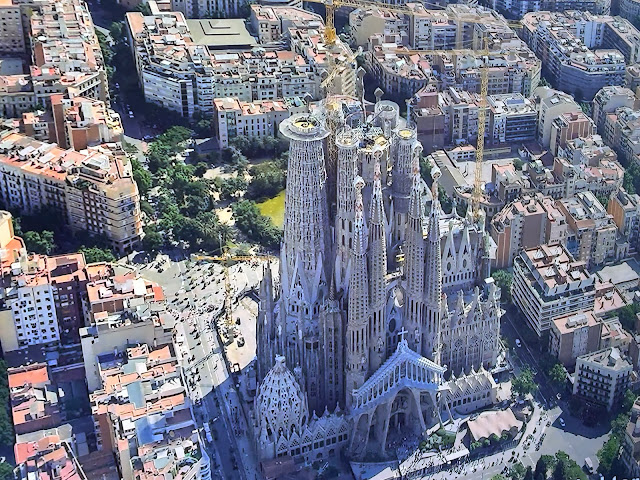The Sagrada Familia is a place to go see extraordinary architecture based inspired by nature's many forms. In side is a place of calm and beauty that makes one slow down and enjoy the moment. Before I start showing pictures in future posts (today and tomorrow), a little history.
The Sagrada Familia is not what its initial founder intended. Bookseller and philanthropist Josep Maria Bocabella Verdaguer commissioned the building of a neo Gothic cathedral with Francisco del Villar as architect. Building started in 1882 and after a year Villar left because of the restrictive financial oversight by the construction committee.
Joan Martorell, the technical advisor, was offered the job but he passed it to his apprentice, Antoni Gaudi. The crypt was well on its way to being completed and Gaudi finished it according to the original designs. In 1889 after the crypt was done, and a very large donation assured economic stability, Gaudi was approved to move forward with his vision of the Apse (area around the main altar), a gothic style with his own additions. After the Apse was completed in 1894, Gaudi had more designs approved and with additional funding proceeded with his vision.
In 1914 Gaudi refused new commissions and focused entirely on the Sagrada Familia. In 1925, all that remained of the Nativity façade was the bell towers. Unfortunately, the next year, he was hit by a tram when walking home and died. When he had a funeral procession to the Sagrada Familia and was buried in its crypt, it was said that he walked home alone and returned with the entire city. The city was fascinated by Antoni Gaudi's vision.
In Gaudi's career, he utilized what he saw in nature to build structures and decorative elements that garnered fame and recognition. He treated his worker as family, including having them scale down jobs as they got older and less able to do the same as the younger workers. He lived simply and tried to treat people well. After his death the cathedral was able to continue because of the elaborate planning that had been done. Whether it was through the Spanish civil war or the wax and wane of funding.
The construction committee would use Gaudi's vision as the underpinning of the rest of the building but that did not mean they were fanatical. Newer ideas that fit with Gaudi's style would be approved over the next hundred years until it nears completion in under a decade.
A recommended book for a wealth of detail on the history and future of the structure is "Sagrada Familia: The Astonishing Story of Gaudi's Unfinished Masterpiece" by Gijs van Hensbergen.
Note: The picture is an aerial photo in the basement museum of the Sagrada Familia.


No comments:
Post a Comment